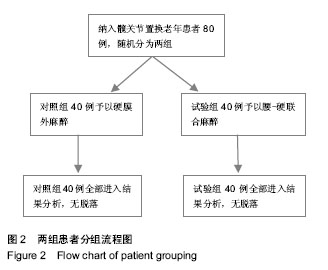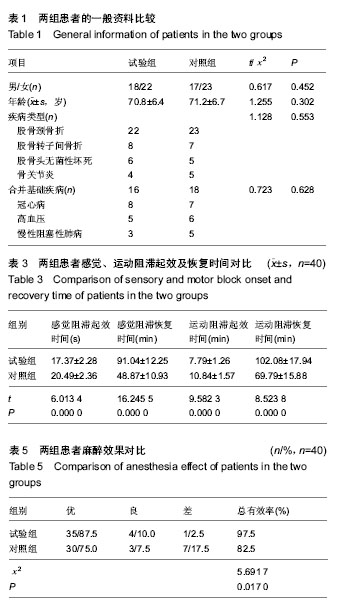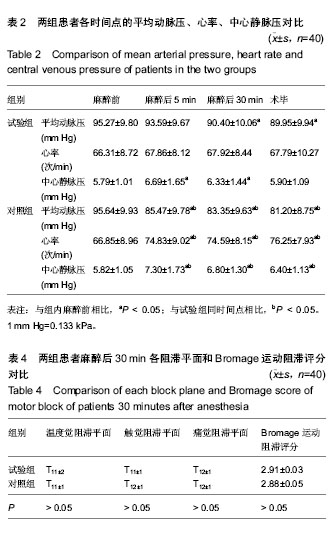| [1] 李召亮,王光磊.不同麻醉方法对老年髋关节置换术患者术中血气及应激反应的影响[J].齐齐哈尔医学院学报, 2012,33(13): 1710-1712.
[2] 申才佳,范海涛,赵勇,等.人工髋关节置换治疗高龄股骨转子间骨折疗效分析[J].安徽医药, 2013,17(1):76-78.
[3] 徐天,王薇薇.对比分析全麻和腰硬联合麻醉在髋关节置换术中的麻醉效果及对血流动力学的影响.[J].医学理论与实践,2014, 27(14):1893-1894.
[4] 夏书江,郭春年,夏晓琼.不同体位腰硬联合麻醉对剖宫产产妇麻醉平面及血流动力学的影响[J].安徽医药, 2014,(10): 1974- 1975, 1976.
[5] 黎永明,邓奋奎.腰硬联合阻滞行高龄患者髋关节置换术108例[J].中华全科医学, 2011,9(4): 543-545.
[6] 陶广才,朱立国. 腰硬联合麻醉与硬膜外麻醉在经尿道前列腺电切术中的临床观察[J].安徽医药, 2011,15(4): 468-469.
[7] 曹晋彪.腰麻-硬膜外麻醉在老年患者人工全髋关节置换术中的应用[J].中国老年保健医学, 2011,9(5):17-18.
[8] 吕德荣,张景晖,陆妍.腰麻-硬膜外联合麻醉在老年患者全髋关节置换术中的应用[J].新乡医学院学报, 2013,30(6): 461-463.
[9] 夏玉正.腰硬联合麻醉与单纯硬膜外麻醉用于剖宫产术效果比较[J].安徽医药, 2011,15(2): 219.
[10] 曹亲亲,郭献阳,陈丽梅,等.不同麻醉方式应用于老年患者髋部手术时的血流动力学变化比较[J].温州医学院学报, 2011,41(1): 33-36.
[11] 吕亮,王福生,卢敏,等.人工髋关节置换术后感染的危险因素分析及预防[J].中华医院感染学杂志,2013,23(6):1334-1336.
[12] 王东伟,陈萍,左会明,等.氟比洛芬酯对髋关节置换术后镇痛效果及TXA_2和GMP-140含量的影响[J].临床麻醉学杂志,2013, 29(5):464-466.
[13] 区广鹏,肖军,郑佐勇,等.金属大头全髋关节置换术和半髋关节置换术治疗老年人股骨颈骨折的近期疗效比较[J].中国老年学杂志,2013,33(14):3292-3293.
[14] 蔡伟华,张良清,李志艺.全身麻醉和硬膜外麻醉对老年骨科患者术后短期认知功能的影响[J].中国老年学杂志,2013,33(12): 2783-2784.
[15] 张勤,王晔,刘祯庆.硬膜外麻醉及腰硬联合麻醉对高龄骨水泥半髋置换术中发生骨水泥植入综合征的影响[J].实用医学杂志, 2012,28(7):1113-1115.
[16] 高策.腰硬联合麻醉与硬膜外麻醉对子宫切除术患者免疫细胞及激素水平的影响[J].中国妇幼保健,2014,29(22):3678-3681.
[17] 李圣君,李九会,陈宗仁.硬膜外麻醉与腰-硬联合麻醉用于老年患者下肢骨折的效果[J].中国老年学杂志,2012,32(7):1514-1515.
[18] 蔡伟华,张良清,李志艺.全身麻醉和硬膜外麻醉对老年骨科患者术后短期认知功能的影响[J].中国老年学杂志,2013,33(12): 2783-2784.
[19] 职爱丽.等效剂量罗哌卡因、布比卡因腰-硬联合麻醉用于高龄患者股骨颈骨折手术的对比研究[J].重庆医学,2012,41(1): 73-75.
[20] 岳永猛,陈力,熊陈,等.全麻和腰硬联合麻醉用于髋关节置换术的麻醉效果比较[J].中国老年学杂志,2013,33(12):2781-2782.
[21] 钱传沐,张兴安,毋楠,等.右美托咪定用于腰-硬联合麻醉下肢手术自控镇静的临床研究[J].临床麻醉学杂志,2014,30(1):31-35.
[22] 高喜文,段强.老年骨科患者腰-硬联合麻醉的临床效果及安全性[J].中国老年学杂志,2014,34(23):6799-6801.
[23] 廖明锋,迟晓慧,邓玉春,等.右美托咪定用于老年患者低位硬膜外麻醉22例[J].医药导报,2012,31(1):40-42.
[24] 夏江燕,孙永瀛,袁静,等.腰-硬联合麻醉与全麻对麻黄碱升压反应影响的比较[J].临床麻醉学杂志,2013,29(12):1157-1159.
[25] 胡劲杨.老年骨科患者腰-硬联合麻醉的临床效果及安全性[J].中国老年学杂志,2013,33(13):3174-3175.
[26] 史克祥,刘红.咪达唑仑伍用芬太尼硬膜外麻醉的镇静效果[J].中国老年学杂志,2012,32(4):726-727.
[27] 唐彦明,杨晓春,吴嘉宾,等.低比重罗哌卡因复合舒芬太尼腰-硬联合麻醉在高龄髋关节手术中的应用[J].重庆医学,2013,42(30): 3666-3668.
[28] 罗中兵,张燕辉,宋晓阳,等.联合腰麻硬膜外麻醉或全凭静脉麻醉用于经皮肾镜碎石术[J].重庆医学,2015,44(2):251-253.
[29] 李熊刚.硬膜外麻醉空气压迫脊髓致死亡1例[J].重庆医学,2015, 44(2):285-286.
[30] 方向东,谢雷.腰-硬联合麻醉致脊髓损伤一例[J].临床麻醉学杂志, 2015,31(1):102.
[31] 蔡爱球,李锐,刘甦.腰硬联合麻醉对腹腔镜阑尾切除术后高龄患者认知功能障碍的影响[J].中国老年学杂志,2015,35(2): 327-328.
[32] 李朝光,徐一刚,吴艳,等.右美托咪定减轻腰-硬联合麻醉下剖宫产产妇寒战反应的效果[J].江苏医药,2014,40(22):2709-2711.
[33] 张维娥,邵雪梅.丙泊酚联合硬膜外麻醉在俯卧位经皮肾镜钬激光碎石术中的应用[J].临床麻醉学杂志,2014,30(11):1129-1130.
[34] 林献忠,肖义荣,曾凯,等.低位硬膜外麻醉对老年高血压患者麻醉诱导期心率变异性的影响[J].中国老年学杂志,2013,33(23): 5868-5870.
[35] 刘伯臣,殷文,刘晓波.硬膜外麻醉致下肢严重感觉障碍四例[J].临床麻醉学杂志,2013,29(11):1139-1140.
[36] 马春,陈兰.腰麻-硬膜外联合麻醉用于80岁以上老年人下肢手术的临床观察[J].现代预防医学,2014,41(1):183-185.
[37] 张辉,姜春南.右美托咪啶预防腰-硬联合麻醉期寒战反应的效果[J].江苏医药,2013,39(24):3058-3059.
[38] 李俊领,杨艳梅,欧玉娥.全身麻醉和硬膜外麻醉对老年前列腺汽化术患者术后认知功能的影响[J].中国老年学杂志,2014,34(3): 667-668.
[39] 钱传沐,张兴安,毋楠,等.右美托咪定用于腰-硬联合麻醉下肢手术自控镇静的临床研究[J].临床麻醉学杂志,2014,30(1):31-35.
[40] 韩爱迪,杨辉,逄坤芳,等.腹腔镜胃肠手术时复合硬膜外麻醉减少全凭静脉麻醉丙泊酚的用量[J].临床麻醉学杂志,2014,30(4): 339-342. |



.jpg)